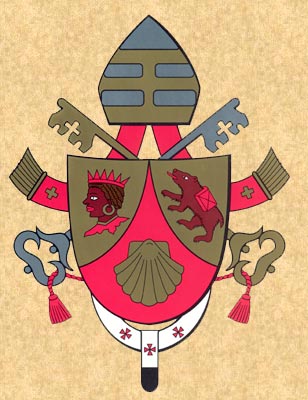
The Vatican website now has Benedict XVI's coat of arms online, along with an entire section on the new pope that includes a short biography and his recent homilies as pope (see link ). According to reports, the Moor's head on the coat of arms originates with the arms of the Archdiocese of Munich-Freising where the Pope was once cardinal-archbishop. According to at least one news report, Benedict views this African symbol as emblematic of the universality of the Church. It is an apt symbol given the spectacular growth of the Church in Africa. The bear carrying a burden is another symbol connected to Munich and refers to a legend that a German bishop-saint had a bear carry his baggage to Rome because the bear had killed the saint's horse. According to EWTN, the bear carrying the burden symbolizes the "burden of office." In my view, based on the autobiography of Cardinal Ratzinger, the bear also symbolizes Christian discipleship in general. The scallop shell is the great symbol of Christian pilgrimage, especially connected to the great shrine of St. James the Greater in Santiago de Compostela located in the northwestern Spanish region of Galicia. Santiago was a great medieval pilgrimage site outdone in prestige only by Rome and Jerusalem. Pilgrims today still flock to Santiago. (My own personal observation: Interestingly, Santiago is connected with the Spanish Christian reconquest of the Iberian peninsula from the Moslem invaders. Are there contemporary European parallels here?) Finally, the wool pallium at the bottom is apparently a novel addition to papal coats of arms and symbolizes the Pope's role as bishop and as pastor of the universal Church. You can find more details about the coat of arms at EWTN report and in this Catholic report
posted by Oswald Sobrino at 7:33 AM
Permanent Link / Discuss This
2 comments
Comments:
Note too that the triple-crown papal tiara has been replaced with a simple mitre, and that the palium has been added to the bottom as a device. Intersting! Thank you for sharing!
posted by Teófilo (Theophilus) : 11:43 AM
Perhaps there's a historical significance to the African symbol, too, since the first few centuries of Christianity made great strides in Africa, too, e.g., St. Anthony of Egypt and St. Augustine of Hippo.
posted by Jeff Tan : 8:31 PMPost a Comment
http://catholicanalysis.blogspot.com/














0 Comments:
Post a Comment
<< Home